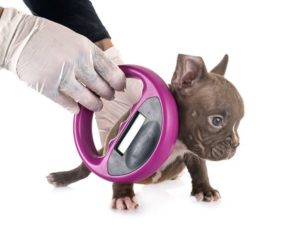
The Importance of Microchipping Your Pet
For anyone who has a presence on social media, it is hard for a day to pass without seeing a posting involving someone who has found a lost pet or an owner seeking a lost pet. Although some breeders still tattoo their puppies, the majority have made the switch to microchipping as a simple, safe and quick means of permanently providing your pet with a permanent, unique form of identification. The microchip itself is about the size of a grain of rice and it is inserted below the skin through a quick injection, just like a routine vaccination. Everyone – breeders, veterinarians, shelters – inserts the chip in the same location – over the point of the right shoulder or between the shoulder blades for dogs or cats. In horses, it is inserted on the left neck.
Any dog or cat can be microchipped at any age. If your puppy or kitten was not microchipped prior to you picking them up, then your veterinarian will likely suggest that they are chipped when they are spayed or neutered. If you initially declined, but later reconsidered at a later date, it is very easy to have it done. The needle in which the microchip resides is larger than needles used for vaccines, but they are extremely sharp, and most pets are oblivious to the quick procedure.
An owner may feel that traditional collars and tattoos are still the way to go. Tags become worn and illegible and the collars may slip off, break off or not be on the pet when they go for a walk-about. With a microchip, however, that cannot happen. Where the pet goes, the microchip goes.These chips have been designed to stay in one place and the vast majority of them will stay in place. Rarely one might begin to migrate a few inches over the years. One would never know this was happening, so what is a prudent practice is to have your veterinarian scan your pet once a year, every year when they are in for their annual physical exam and whatever vaccines are required. This will give an owner the confidence that the microchip will readily be detected should their pet get lost.
When a chip is scanned with a microchip reader, the reader displays a unique multi-digit. The first few digits refer to the company who produced the chip and whose database the chip is registered. The shelter or veterinary hospital can then call the company and find out who the owner is. One might assume that whoever microchipped the pet did, in fact, do the registration. However, it would be wise for every owner to double check that this was done and call the microchip company themselves to make sure all the information is correct. Should the family move or change phone numbers, then obviously the company must be made aware of this as well, as the microchip is only as good as the information attached to it.
Microchips are RFID (radio frequency ID) and do not transmit any data; they are read-only. At present, though, the primary function of a microchip is to get your pet safely home as quickly as possible. They are very effective at accomplishing this task and every owner should consider this as very worthwhile for their pet. Having ID tags on a collar is still very worthwhile with pertinent information that can hopefully shorten the process of retrieving your pet before they get picked up by somebody.
Bioscint Engineering supplies microchips and microchip scanners from leading brand Trovan. Kindly get in touch with us for more information or you can purchase these directly from our online shop.







